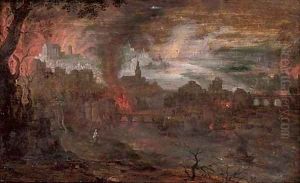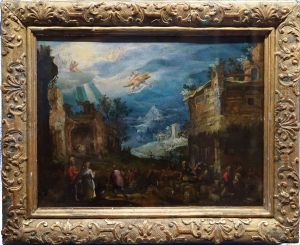Frederik Van Valckenborch Paintings
Frederik Van Valckenborch was a Flemish painter and draughtsman born in 1566 in Mechelen, which was part of the Habsburg Netherlands. He hailed from a family of artists; his father, Marten van Valckenborch, and his uncle, Lucas van Valckenborch, were both accomplished painters known for their landscapes and cityscapes. Frederik's work was heavily influenced by this artistic environment, and he continued the family tradition, specializing in similar genres.
The Van Valckenborch family, like many other Protestant artists, moved away from the Spanish-controlled Southern Netherlands due to religious persecution. They settled in Frankfurt am Main, which was a part of the Holy Roman Empire, around 1586. It was in this city that Frederik likely received his training and developed his artistic skills. He became a master in the Frankfurt Guild of St. Luke in 1592, suggesting that by this time, he had established himself as an independent artist.
Frederik Van Valckenborch is known for his landscapes, often imbued with a Mannerist sensibility characterized by fantastical elements, exaggerated proportions, and vibrant colors. His works also show influence from the Northern Renaissance, with a keen attention to detail and a penchant for depicting the natural world and human figures in harmony.
He often collaborated with his father and uncle, contributing figures or other details to their landscapes. This collaborative approach was common in artist families of the time. Frederik's body of work includes both paintings and drawings, with the majority of his surviving oeuvre being landscapes.
Frederik Van Valckenborch's career spanned the transition from the late Renaissance to the early Baroque period, but he remained largely faithful to the Mannerist style throughout his life. He died in 1623 in Frankfurt am Main. His works are less well-known today than those of some of his contemporaries, but they remain a testament to the rich artistic milieu of Flemish landscape painters who were active in Europe at the turn of the 17th century.

